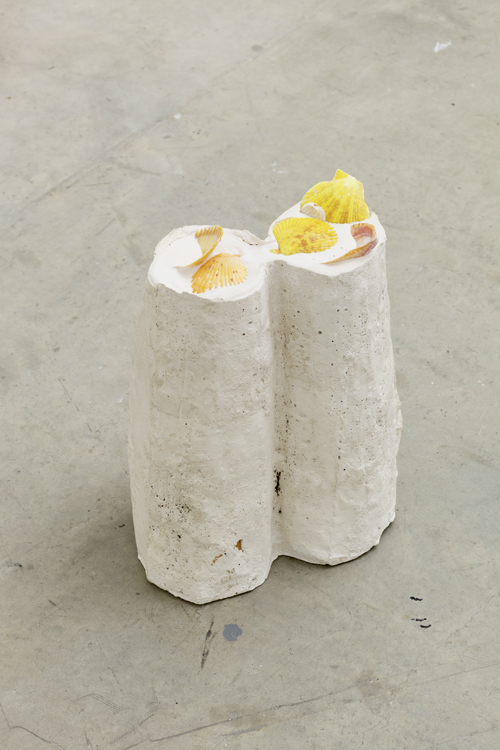Anna Zacharoff
Still Waters
Still Waters

Anna Zacharoff’s paintings are populated with all kinds of marine life: sea snails, oysters and fish rendered in delicate watercolours, oils and pastels. In Kvikk Lunsj (2014), for example, a mix of timidly washed out and impulsively vivid brushstrokes bring forth the outlines of a tortoise. Its shell is merely hinted at but the inclined head is precisely rendered: the animal’s large eye looks mournfully out at the viewer. The tortoise seems to be suspended in a void, with only peripheral traces of paint anchoring it to the otherwise empty, unprimed canvas. At second glance, however, the canvas’s emptiness appears as a fitting substitute for the endless expanse of the ocean. An air of melancholy hangs over this work, suggesting the romantically idealized solitude of the open sea.
The Frankfurt am Main-based artist leaves the viewer in the dark as to the cryptic references that shape these characters, but in conversation she speaks of biological studies on brainless sponges that sneeze – as cited in Ellen Prager’s Sex, Drugs, and Sea Slime: The Ocean’s Oddest Creatures (2012) – literature like Hans Christian Andersen’s The Little Mermaid (1837), or the fact that she was once given the nickname ‘Lobster’. On her canvases themselves, all that remains are the illustrative, cartoon-like motifs: reduced to bare essentials and preserved separately like zoological specimens for the viewer’s scrutiny.

In Zacharoff’s joint show with George Rippon at New York’s Svetlana Gallery in March, Harmonie Grunge, her isolated scenes were interrupted by Rippon’s cheery installation-based works. A spider conch with majestic spines rested on the suggestion of a glowing yellow seabed and a hermit crab seemed to drift aimlessly in water (both with or without you, 2015). Meanwhile, on the gallery floor, Rippon’s Fish in the Dark (2015) – consisting of dried flowers, a fragment of text, miniature figures carrying brief-cases, and a photograph of stacked glasses in a bar, all arranged on a cast ceramic slab – told a far more specific story: that of the tumult of urban displacement in big cities like Frankfurt or New York. A stuffed toy husky placed its paw proprietorially over the object and some of Rippon’s miniature figures had even climbed a nearby cornice while a few had scaled the top of Zacharoff’s canvases.

Zacharoff’s sculptures however, like her paintings, bear marine themes: three foam tortoises with plump limbs (e.g. Turtle # 1 Maggie, 2014) looked as if they were dragging themselves across the gallery floor of her solo exhibition at Bianca d’Alessandro gallery in Copenhagen last year (inevitably recalling the pop stoicism of Cosima von Bonin’s figures). Similarly, plaster casts of flipper-like feet imprinted with pastel-coloured shells (e.g. Diver (foot), 2014) seemed to transform the gallery space of Vilma Gold in London in 2014 into a seabed strewn with the remains of crumbling, sunken statues. For her next solo show, in September 2015 at Neue Alte Brücke in Frankfurt (titled Happy new Christmas), Zacharoff plans to take the combination of painting and sculpture to a more literal level. In a new work, the canvas itself will become a sculpture: a linen cloth bearing a picture of a crab is stretched horizontally over a three-legged wooden structure, forming a stool from which hangs an empty fishing net. At the point where the wooden legs intersect is a small white towel with typically nautical navy blue stripes.
Zacharoff’s objects free the creatures of her painting from their solitude, but with their often awkward and clumsy appearance they also forfeit some of the animals’ graceful aura. This sweet neo-romantic escape into remote submarine depths is overlaid with a wistful humour that never converges into a coherent punchline. Via repetition, this kind of slapstick coaxes a certain absurdity from the same underwater motifs; in the stagnation of these slightly faltering creatures, it shines through like a recurring joke – like Eel (2014) with its bulging eyes and gaping mouth, looking as if it is frozen in motion, helplessly trapped in a comical pose.
Whether fixed on canvas or crawling exhaustedly across the floor, Zacharoff’s quaint creatures invite a kind of pity – until one gets the feeling that they are looking back. What begins, for example, with the mute stare of a lionfish (Lionfish #2, 2014) turns into what British art historian T. J. Clark has described as an ‘exchange of gazes’: the viewer’s impression of being reflected in the creature’s eyes. Finally, then, it seems as if Zacharoff’s works hold up a mirror in which we recognize ourselves as the fools being spied on. Meanwhile, the lionfish grins to itself, knowingly.
Translated by Nicholas Grindell

















